Drug Catalog - Product Detail
LEVOTHYROXINE SODIUM,USP TB 0.088MG 90
| NDC | Mfr | Size | Str | Form |
|---|---|---|---|---|
| 00378-1807-77 | MYLAN | 90 | 88MCG | TABLET |
PACKAGE FILES
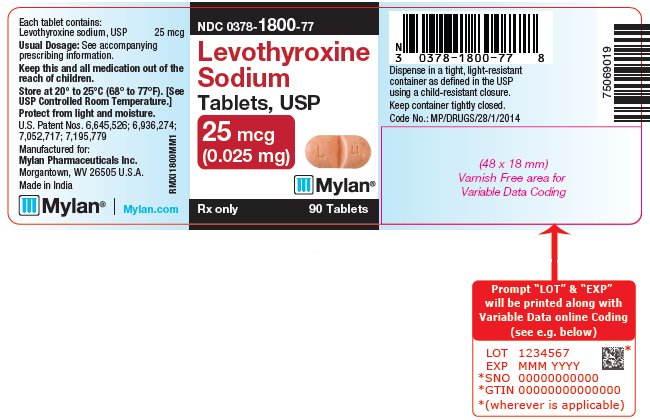
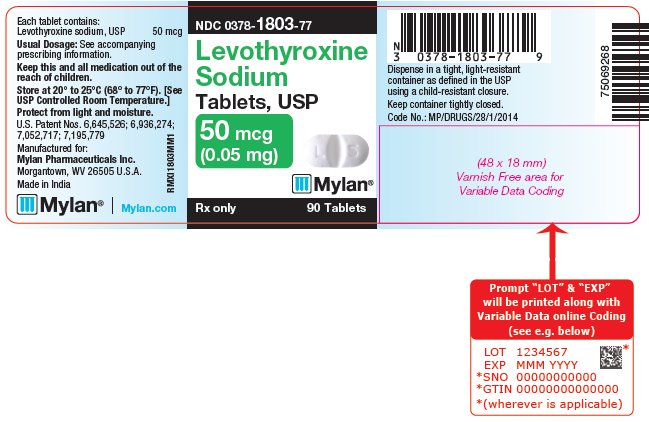
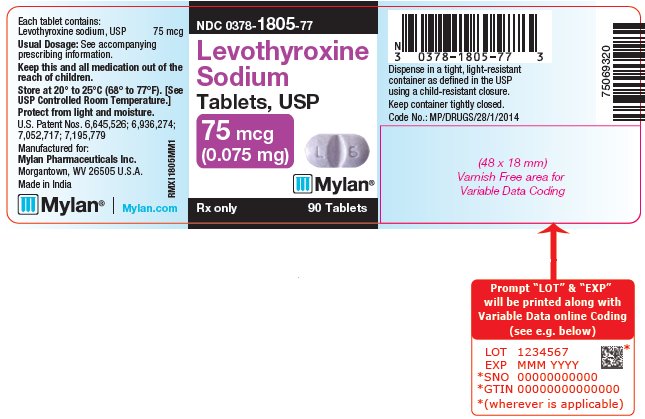

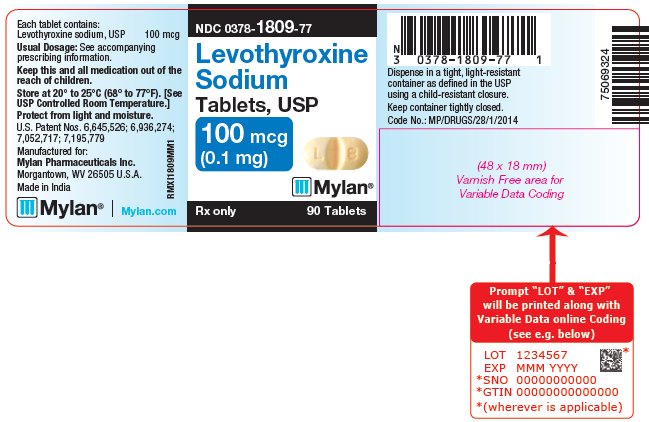
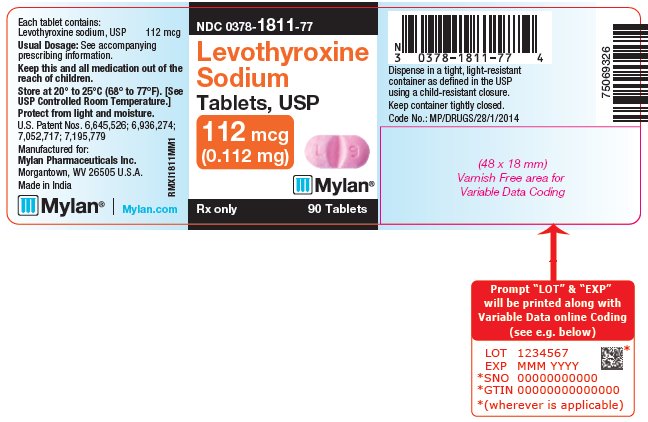

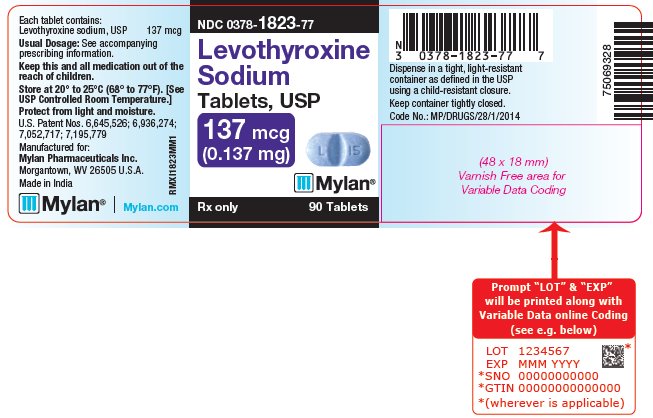


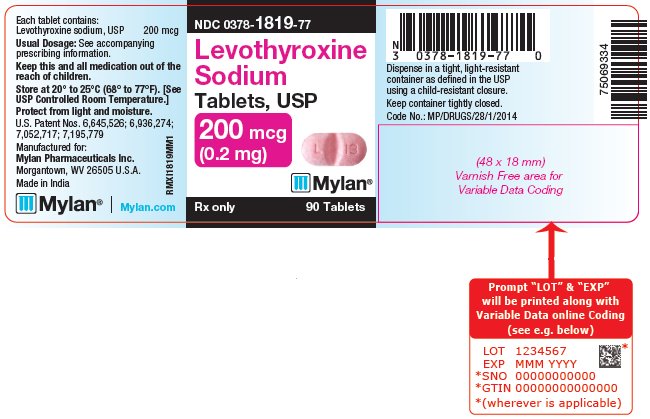
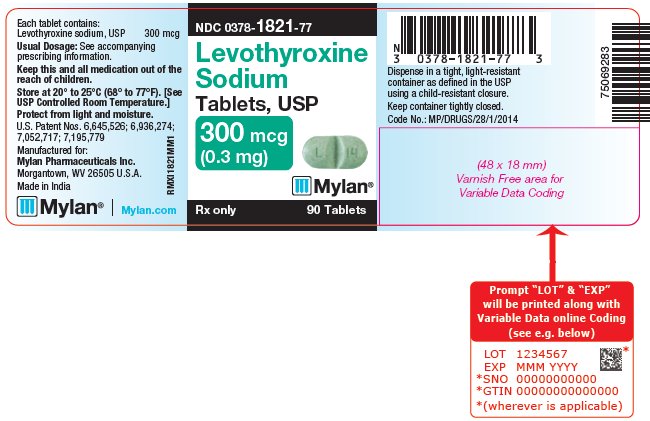

Generic Name
LEVOTHYROXINE SODIUM
Substance Name
LEVOTHYROXINE SODIUM
Product Type
HUMAN PRESCRIPTION DRUG
Route
ORAL
Application Number
ANDA076187
Description
11 DESCRIPTION Levothyroxine sodium tablets, USP is L-thyroxine (T4) and contains synthetic crystalline L-3,3',5,5'-tetraiodothyronine sodium salt. Synthetic T4 is chemically identical to that produced in the human thyroid gland. Levothyroxine (T4) sodium has an empirical formula of C 15 H 10 I 4 N NaO 4 • H 2 O, molecular weight of 798.86 g/mol (anhydrous), and structural formula as shown: Levothyroxine sodium tablets for oral administration are supplied in the following strengths: 25 mcg, 50 mcg, 75 mcg, 88 mcg, 100 mcg, 112 mcg, 125 mcg, 137 mcg, 150 mcg, 175 mcg, 200 mcg, and 300 mcg. Each levothyroxine sodium tablet contains the inactive ingredients butylated hydroxyanisole, colloidal silicon dioxide, crospovidone, magnesium stearate, mannitol, microcrystalline cellulose, povidone, sodium lauryl sulfate and sucrose. Table 9 provides a listing of the color additives by tablet strength: Table 9. Levothyroxine Sodium Tablets Color Additives Strength (mcg) Color additive(s) 25 FD&C Yellow No. 6 Aluminum Lake 50 None 75 FD&C Blue No. 2 Aluminum Lake, FD&C Red No. 40 Aluminum Lake 88 D&C Yellow No. 10 Aluminum Lake, FD&C Blue No. 1 Aluminum Lake, FD&C Yellow No. 6 Aluminum Lake 100 D&C Yellow No. 10 Aluminum Lake, FD&C Yellow No. 6 Aluminum Lake 112 D&C Red No. 27 Aluminum Lake, D&C Red No. 30 Aluminum Lake 125 FD&C Blue No. 1 Aluminum Lake, FD&C Red No. 40 Aluminum Lake, FD&C Yellow No. 6 Aluminum Lake 137 FD&C Blue No. 2 Aluminum Lake 150 FD&C Blue No. 2 Aluminum Lake 175 D&C Red No. 27 Aluminum Lake, D&C Red No. 30 Aluminum Lake, FD&C Blue No. 1 Aluminum Lake 200 FD&C Red No. 40 Aluminum Lake 300 D&C Yellow No. 10 Aluminum Lake, FD&C Blue No. 1 Aluminum Lake, FD&C Yellow No. 6 Aluminum Lake Levothyroxine Structural Formula
How Supplied
16 HOW SUPPLIED/STORAGE AND HANDLING How Supplied Levothyroxine Sodium Tablets, USP are available containing 25 mcg, 50 mcg, 75 mcg, 88 mcg, 100 mcg, 112 mcg, 125 mcg, 137 mcg, 150 mcg, 175 mcg, 200 mcg or 300 mcg of levothyroxine sodium, USP. They are available as follows: The 25 mcg tablets are orange, capsule-shaped, scored tablets debossed with L to the left of the score and 4 to the right of the score on one side of the tablet and M on the other side. NDC 0378-1800-77 bottles of 90 tablets NDC 0378-1800-10 bottles of 1000 tablets The 50 mcg tablets are white, capsule-shaped, scored tablets debossed with L to the left of the score and 5 to the right of the score on one side of the tablet and M on the other side. NDC 0378-1803-77 bottles of 90 tablets NDC 0378-1803-10 bottles of 1000 tablets The 75 mcg tablets are violet, capsule-shaped, scored tablets debossed with L to the left of the score and 6 to the right of the score on one side of the tablet and M on the other side. NDC 0378-1805-77 bottles of 90 tablets NDC 0378-1805-10 bottles of 1000 tablets The 88 mcg tablets are olive, capsule-shaped, scored tablets debossed with L to the left of the score and 7 to the right of the score on one side of the tablet and M on the other side. NDC 0378-1807-77 bottles of 90 tablets NDC 0378-1807-10 bottles of 1000 tablets The 100 mcg tablets are yellow, capsule-shaped, scored tablets debossed with L to the left of the score and 8 to the right of the score on one side of the tablet and M on the other side. NDC 0378-1809-77 bottles of 90 tablets NDC 0378-1809-10 bottles of 1000 tablets The 112 mcg tablets are rose, capsule-shaped, scored tablets debossed with L to the left of the score and 9 to the right of the score on one side of the tablet and M on the other side. NDC 0378-1811-77 bottles of 90 tablets NDC 0378-1811-10 bottles of 1000 tablets The 125 mcg tablets are gray, capsule-shaped, scored tablets debossed with L to the left of the score and 10 to the right of the score on one side of the tablet and M on the other side. NDC 0378-1813-77 bottles of 90 tablets NDC 0378-1813-10 bottles of 1000 tablets The 137 mcg tablets are turquoise, capsule-shaped, scored tablets debossed with L to the left of the score and 15 to the right of the score on one side of the tablet and M on the other side. NDC 0378-1823-77 bottles of 90 tablets NDC 0378-1823-10 bottles of 1000 tablets The 150 mcg tablets are blue, capsule-shaped, scored tablets debossed with L to the left of the score and 11 to the right of the score on one side of the tablet and M on the other side. NDC 0378-1815-77 bottles of 90 tablets NDC 0378-1815-10 bottles of 1000 tablets The 175 mcg tablets are lilac, capsule-shaped, scored tablets debossed with L to the left of the score and 12 to the right of the score on one side of the tablet and M on the other side. NDC 0378-1817-77 bottles of 90 tablets NDC 0378-1817-10 bottles of 1000 tablets The 200 mcg tablets are pink, capsule-shaped, scored tablets debossed with L to the left of the score and 13 to the right of the score on one side of the tablet and M on the other side. NDC 0378-1819-77 bottles of 90 tablets NDC 0378-1819-10 bottles of 1000 tablets The 300 mcg tablets are green, capsule-shaped, scored tablets debossed with L to the left of the score and 14 to the right of the score on one side of the tablet and M on the other side. NDC 0378-1821-77 bottles of 90 tablets Storage and Handling Store at 20° to 25°C (68° to 77°F). [See USP Controlled Room Temperature.] Protect from light and moisture. Dispense in a tight, light-resistant container as defined in the USP using a child-resistant closure.
Indications & Usage
1 INDICATIONS AND USAGE Hypothyroidism Levothyroxine sodium tablets are indicated in adult and pediatric patients, including neonates, as a replacement therapy in primary (thyroidal), secondary (pituitary), and tertiary (hypothalamic) congenital or acquired hypothyroidism. Pituitary Thyrotropin (Thyroid-Stimulating Hormone, TSH) Suppression Levothyroxine sodium tablets are indicated in adult and pediatric patients, including neonates, as an adjunct to surgery and radioiodine therapy in the management of thyrotropin-dependent well-differentiated thyroid cancer. Limitations of Use • Levothyroxine sodium tablets are not indicated for suppression of benign thyroid nodules and nontoxic diffuse goiter in iodine-sufficient patients as there are no clinical benefits and overtreatment with levothyroxine sodium tablets may induce hyperthyroidism [see Warnings and Precautions (5.1) ]. • Levothyroxine sodium tablets are not indicated for treatment of hypothyroidism during the recovery phase of subacute thyroiditis. Levothyroxine sodium tablets are a L-thyroxine (T4) indicated in adult and pediatric patients, including neonates, for: • Hypothyroidism: As replacement therapy in primary (thyroidal), secondary (pituitary), and tertiary (hypothalamic) congenital or acquired hypothyroidism. ( 1 ) • Pituitary Thyrotropin (Thyroid-Stimulating Hormone, TSH) Suppression: As an adjunct to surgery and radioiodine therapy in the management of thyrotropin-dependent well-differentiated thyroid cancer. ( 1 ) Limitations of Use: • Not indicated for suppression of benign thyroid nodules and nontoxic diffuse goiter in iodine-sufficient patients • Not indicated for treatment of hypothyroidism during the recovery phase of subacute thyroiditis
Dosage and Administration
2 DOSAGE AND ADMINISTRATION • Administer once daily, preferably on an empty stomach, one-half to one hour before breakfast. ( 2.1 ) • Administer at least 4 hours before or after drugs that are known to interfere with absorption. ( 2.1 ) • Evaluate the need for dose adjustments when regularly administering within one hour of certain foods that may affect absorption. ( 2.1 ) • Advise patients to stop biotin and biotin-containing supplements at least 2 days before assessing TSH and/or T4 levels. ( 2.2 ) • Starting dose depends on a variety of factors, including age, body weight, cardiovascular status, and concomitant medications. Peak therapeutic effect may not be attained for 4-6 weeks. ( 2.2 ) • See full prescribing information for dosing in specific patient populations. ( 2.3 ) • Adequacy of therapy determined with periodic monitoring of TSH and/or T4 as well as clinical status. ( 2.4 ) 2.1 Important Administration Instructions Administer levothyroxine sodium tablets as a single daily dose, on an empty stomach, one-half to one hour before breakfast. Administer levothyroxine sodium tablets at least 4 hours before or after drugs known to interfere with levothyroxine sodium tablets absorption [see Drug Interactions (7.1) ] . Evaluate the need for dosage adjustments when regularly administering within one hour of certain foods that may affect levothyroxine sodium tablets absorption [see Dosage and Administration (2.2 and 2.3 ), Drug Interactions (7.9) , and Clinical Pharmacology (12.3) ] . Administer levothyroxine sodium tablets to pediatric patients who cannot swallow intact tablets by crushing the tablet, suspending the freshly crushed tablet in a small amount (5 to 10 mL) of water and immediately administering the suspension by spoon or dropper. Ensure the patient ingests the full amount of the suspension. Do not store the suspension. Do not administer in foods that decrease absorption of levothyroxine sodium tablets, such as soybean-based infant formula [see Drug Interactions (7.9) ] . 2.2 Important Considerations for Dosing The dosage of levothyroxine sodium tablets for hypothyroidism or pituitary TSH suppression depends on a variety of factors including: the patient's age, body weight, cardiovascular status, concomitant medical conditions (including pregnancy), concomitant medications, co-administered food and the specific nature of the condition being treated [see Dosage and Administration (2.3) , Warnings and Precautions (5) , and Drug Interactions (7) ] . Dosing must be individualized to account for these factors and dosage adjustments made based on periodic assessment of the patient's clinical response and laboratory parameters [see Dosage and Administration (2.4) ] . For adult patients with primary hypothyroidism, titrate until the patient is clinically euthyroid and the serum TSH returns to normal [see Dosage and Administration (2.3) ] . For secondary or tertiary hypothyroidism, serum TSH is not a reliable measure of levothyroxine sodium tablets dosage adequacy and should not be used to monitor therapy. Use the serum free-T4 level to titrate levothyroxine sodium tablets dosing until the patient is clinically euthyroid and the serum free-T4 level is restored to the upper half of the normal range [see Dosage and Administration (2.3) ] . Inquire whether patients are taking biotin or biotin-containing supplements. If so, advise them to stop biotin supplementation at least 2 days before assessing TSH and/or T4 levels [see Dosage and Administration (2.4) and Drug Interactions (7.10) ] . The peak therapeutic effect of a given dose of levothyroxine sodium tablets may not be attained for 4 to 6 weeks. 2.3 Recommended Dosage and Titration Primary, Secondary, and Tertiary Hypothyroidism in Adults The recommended starting daily dosage of levothyroxine sodium tablets in adults with primary, secondary, or tertiary hypothyroidism is based on age and comorbid cardiac conditions, as described in Table 1. For patients at risk of atrial fibrillation or patients with underlying cardiac disease, start with a lower dosage and titrate the dosage more slowly to avoid exacerbation of cardiac symptoms. Dosage titration is based on serum TSH or free-T4 [see Dosage and Administration (2.2) ] . Table 1. Levothyroxine Sodium Tablets Dosing Guidelines for Hypothyroidism in Adults Dosages greater than 200 mcg/day are seldom required. An inadequate response to daily dosages greater than 300 mcg/day is rare and may indicate poor compliance, malabsorption, drug interactions, or a combination of these factors [see Dosage and Administration (2.1) and Drug Interactions (7) ] . Patient Population Starting Dosage Dosage Titration Based on Serum TSH or Free-T4 Adults diagnosed with hypothyroidism Full replacement dose is 1.6 mcg/kg/day. Some patients require a lower starting dose. Titrate dosage by 12.5 to 25 mcg increments every 4 to 6 weeks, as needed until the patient is euthyroid. Adults at risk for atrial fibrillation or with underlying cardiac disease Lower starting dose (less than 1.6 mcg/kg/day) Titrate dosage every 6 to 8 weeks, as needed until the patient is euthyroid. Geriatric patients Lower starting dose (less than 1.6 mcg/kg/day) Primary, Secondary, and Tertiary Hypothyroidism in Pediatric Patients The recommended starting daily dosage of levothyroxine sodium tablets in pediatric patients with primary, secondary, or tertiary hypothyroidism is based on body weight and changes with age as described in Table 2. Titrate the dosage (every 2 weeks) as needed based on serum TSH or free-T4 until the patient is euthyroid [see Dosage and Administration (2.2) ] . Table 2. Levothyroxine Sodium Tablets Dosing Guidelines for Hypothyroidism in Pediatric Patients Age Starting Daily Dosage Per Kg Body Weight Adjust dosage based on clinical response and laboratory parameters [see Dosage and Administration (2.4) and Use in Specific Populations (8.4) ] . 0-3 months 10-15 mcg/kg/day 3-6 months 8-10 mcg/kg/day 6-12 months 6-8 mcg/kg/day 1-5 years 5-6 mcg/kg/day 6-12 years 4-5 mcg/kg/day Greater than 12 years but growth and puberty incomplete 2-3 mcg/kg/day Growth and puberty complete 1.6 mcg/kg/day Pediatric Patients from Birth to 3 Months of Age at Risk for Cardiac Failure Start at a lower starting dosage and increase the dosage every 4 to 6 weeks as needed based on clinical and laboratory response. Pediatric Patients at Risk for Hyperactivity To minimize the risk of hyperactivity, start at one-fourth the recommended full replacement dosage, and increase on a weekly basis by one-fourth the full recommended replacement dosage until the full recommended replacement dosage is reached. Hypothyroidism in Pregnant Patients For pregnant patients with pre-existing hypothyroidism, measure serum TSH and free-T4 as soon as pregnancy is confirmed and, at minimum, during each trimester of pregnancy. In pregnant patients with primary hypothyroidism, maintain serum TSH in the trimester-specific reference range. The recommended daily dosage of levothyroxine sodium tablets in pregnant patients is described in Table 3. Table 3. Levothyroxine Sodium Tablets Dosing Guidelines for Hypothyroidism in Pregnant Patients Patient Population Starting Dosage Dose Adjustment and Titration Pre-existing primary hypothyroidism with serum TSH above normal trimester-specific range Pre-pregnancy dosage may increase during pregnancy Increase levothyroxine sodium tablets dosage by 12.5 to 25 mcg per day. Monitor TSH every 4 weeks until a stable dose is reached and serum TSH is within normal trimester-specific range. Reduce levothyroxine sodium tablets dosage to pre-pregnancy levels immediately after delivery. Monitor serum TSH 4 to 8 weeks postpartum. New onset hypothyroidism (TSH ≥ 10 mIU per liter) 1.6 mcg/kg/day Monitor serum TSH every 4 weeks and adjust levothyroxine sodium tablets dosage until serum TSH is within normal trimester-specific range. New onset hypothyroidism (TSH < 10 mIU per liter) 1.0 mcg/kg/day TSH Suppression in Well-differentiated Thyroid Cancer in Adult and Pediatric Patients The levothyroxine sodium tablets dosage is based on the target level of TSH suppression for the stage and clinical status of thyroid cancer. 2.4 Monitoring TSH and/or Thyroxine (T4) Levels Assess the adequacy of therapy by periodic assessment of laboratory tests and clinical evaluation. Biotin supplementation may interfere with immunoassays for TSH, T4, and T3, resulting in erroneous thyroid hormone test results. Stop biotin and biotin-containing supplements for at least 2 days before assessing TSH and/or T4 levels [see Drug Interactions (7.10) ] . Persistent clinical and laboratory evidence of hypothyroidism despite an apparent adequate replacement dose of levothyroxine sodium tablets may be evidence of inadequate absorption, poor compliance, drug interactions, or a combination of these factors. Adults In adult patients with primary hypothyroidism, monitor serum TSH levels after an interval of 6 to 8 weeks after any change in dosage. In patients on a stable and appropriate replacement dosage, evaluate clinical and biochemical response every 6 to 12 months and whenever there is a change in the patient’s clinical status. Pediatric Patients In patients with hypothyroidism, assess the adequacy of replacement therapy by measuring both serum TSH and total or free-T4. Monitor TSH and total or free-T4 in pediatric patients as follows: 2 and 4 weeks after the initiation of treatment, 2 weeks after any change in dosage, and then every 3 to 12 months thereafter following dosage stabilization until growth is completed. Poor compliance or abnormal values may necessitate more frequent monitoring. Perform routine clinical examination, including assessment of development, mental and physical growth, and bone maturation, at regular intervals. The general aim of therapy is to normalize the serum TSH level. TSH may not normalize in some patients due to in utero hypothyroidism causing a resetting of pituitary-thyroid feedback. Failure of the serum T4 to increase into the upper half of the normal range within 2 weeks of initiation of levothyroxine sodium tablets therapy and/or of the serum TSH to decrease below 20 mIU per liter within 4 weeks may indicate the patient is not receiving adequate therapy. Assess compliance, dose of medication administered, and method of administration prior to increasing the dose of levothyroxine sodium tablets [see Warnings and Precautions (5.1) and Use in Specific Populations (8.4) ] . Secondary and Tertiary Hypothyroidism Monitor serum free-T4 levels and maintain in the upper half of the normal range in these patients.
